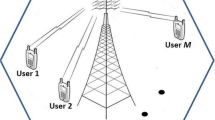Abstract
Block diagonalization (BD) and successive optimization (SO) are two suboptimal but more practical (compared to dirty paper coding (DPC)) orthogonal linear precoding techniques for the downlink of multiuser MIMO systems. Since the numbers of users supported by BD or SO for a given number of transmit antennas are limited, BD or SO should be combined with scheduling so that a subset of users is selected at a given time slot while meeting the dimensionality requirements of these techniques. On the other hand, receive antenna selection (RAS) is a promising hardware complexity reduction technique. In this paper, we consider user scheduling in conjunction with receive antenna selection. Since exhaustive search is computationally prohibitive, we propose simplified and suboptimal user scheduling algorithms for both BD and SO. For BD, we propose capacity and Frobenius-norm based suboptimal algorithms with the objective of sum rate maximization. Starting from an empty set, each step of proposed algorithms adds the best user from the set of users not selected yet until the desired number of users have been selected. Proposed receive antenna selection works in conjunction with user scheduling to further enhance the sum rate of BD. For SO, a Frobenius-norm based low complexity algorithm is proposed, which maximizes the ratio of the squared Frobenius norm of the equivalent channel (projected to the joint null space of the previously selected users) to the sum of the squared Frobenius norms of the previously selected users’ preprocessed channels. Simulation results demonstrate that the proposed algorithms achieve sum rates close to exhaustive search algorithms with much reduced complexity. We also show that in addition to reduced hardware complexity at the receiver, antenna selection enhances multiuser diversity gain that is achieved with user scheduling.
Similar content being viewed by others
References
Costa M. (1993) Writing on dirty paper. IEEE Transactions on Information Theory 29(3): 439–441
Weingarten, H., Steinberg, Y., & Shamai, S. (2004). The capacity region of the Gaussian MIMO broadcast channel. In Proceedings of the IEEE International Symposium on Information Theory (ISIT’04), June, July 2004 (p. 174).
Caire G., Shamai S. (2003) On the achievable throughput of a multiantenna Gaussian broadcast channel. IEEE Transactions on Information Theory 49(7): 1691–1706
Lim, B. C., Schlegel, C., & Krzymień, W. (2006). Efficient receive antenna selection algorithms and framework of trasnmit zero-forcing beamforming. In Proceedings of the IEEE VTC’06-Spring, May 2006.
Spencer Q.H., Swindlehurst A.L., Haardt M. (2004) Zero forcing methods for downlink spatial multiplexing in multiuser MIMO channels. IEEE Transactions on Signal Processing 52((2): 461–471
Choi L., Murch R.D. (2004) A transmit preprocessing technique for multiuser MIMO systems using a decomposition approach. IEEE Transactions on Wireless Communication 3(1): 20–24
Pan Z., Wong K.-K., Ng T.-S. (2004) Generalized multiuser orthogonal space-division multiplexing. IEEE Transactions on Wireless Communication 3(6): 1969–1973
Yoo T., Goldsmith A. (2006) On the optimality of multiantenna broadcast scheduling using zero-forcing beamforming. IEEE Journal on Selected Areas in Communicationa 24(3): 528–541
Dimic G., Sidiropoulos N.D. (2005) On downlink beamforming with greedy user selection: performance analysis and a simple new algorithm. IEEE Transactions on Signal Processing 53(10): 3857–3868
Tu Z., Blum R.S. (2003) Multiuser diversity for a dirty paper approach. IEEE Commun. Lett. 7(8): 370–372
Berenguer, I., Wassell, I. J., & Wang, X. (2005). Opportunistic user scheduling and antenna selection in the downlink of multiuser MISO systems. In Proceedings of the IEEE VTC’05-Spring, May 2005 (pp. 1138–1142).
Shen Z., Chen R., Andrews J.G., Heath J.R.W., Evans B.L. (2006) Low complexity user selection algorithms for multiuser MIMO systems with block diagonalization. IEEE Transactions on Signal Processing 54(9): 3658–3663
Heath, R. W., & Paulraj, A. (2001). Antenna selection for spatial multiplexing systems based on minimum error rate. In Proceedings of the IEEE ICC’01, June 2001 (pp. 2276–2280).
Gorokhov A., Gore D.A., Paulraj A.J. (2003) Receive antenna selection for MIMO spatial multiplexing: Theory and algorithms. IEEE Transactions on Signal Processing 51(11): 2796–2807
Chen, R., Andrews, J. G., & Heath, J. R. W. (2004). Transmit selection diversity for multiuser spatial multiplexing systems. In Proceedings of the IEEE GLOBECOM ’04, Dec 2004 (pp. 2625–2629).
Viswanath P., Tse D.N.C., Laroia R. (2002) Opportunistic beamforming using dumb antennas. IEEE Transactions on Information Theory 48(6): 1277–1294
Sigdel, S., & Krzymień, W. A. (2007). Fair scheduling and antenna selection algorithms for downlink multiuser MIMO orthogonal space division multiplexing. In Proc. IST Mobile and Wireless Communications Summit, Budapest, Hungary, July 2007.
Tejera P., Utschick W., Bauch G., Nossek J.A. (2006) Subchannel allocation in multiuser multiple-input multiple-output systems. IEEE Transactions on Information Theory 52(10): 4721–4733
Jindal N., Rhee W., Vishwanath S., Jafar S.A., Goldsmith A. (2005) Sum power iterative water-filling for multi-antenna Gaussian broadcast channels. IEEE Transactions on Information Theory 51(4): 1570–1580
Sigdel, S., & Krzymień, W. A. (2007). Simplified antenna selection and user scheduling for orthogonal space-division multiplexing. In Proceedings of the IEEE WCNC’07, Hong Kong, March 2007.
Author information
Authors and Affiliations
Corresponding author
Rights and permissions
About this article
Cite this article
Sigdel, S., Krzymień, W.A. Antenna and User Subset Selection in Downlink Multiuser Orthogonal Space-Division Multiplexing. Wireless Pers Commun 52, 227–240 (2010). https://doi.org/10.1007/s11277-008-9503-4
Received:
Accepted:
Published:
Issue Date:
DOI: https://doi.org/10.1007/s11277-008-9503-4




